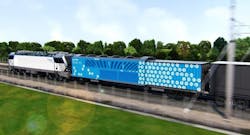Nestlé Waters plans H2 Fuel Cell Train for product transport
Nestlé Group's mineral water business Nestlé Waters says it will become the first company in Europe to use the innovative hydrogen fuel cell solution developed by Alstom and ENGIE for powering rail freight operations.
From 2025, Nestlé Waters’ VITTEL natural mineral water will be transported from the company’s French factory in Vosges to various distribution centers across France, including those in Arles and Montreuil-Bellay, through freight train that uses the proposed high-powered hydrogen fuel cell solution.
The locomotives will be fitted with the dual-mode solution to source electricity from the electrified lines on the main rail network and from hydrogen fuel cell in non-electrified areas to offer a 100% end-to-end electric solution for rail freight, including first and last kilometers, which are rarely electrified.
Fuel-cell technology utilizes a fuel source such as hydrogen to generate electricity. Hydrogen does not emit CO2, although it needs to produced via a clean electrolyzer powered by renewables to be considered green H2.
“At Nestlé Waters, we favor rail freight whenever possible. We are constantly looking for efficient solutions to reduce the carbon impact of our supply chain,” Sophie Dubois, Chief Executive Officer of Nestlé Waters in France, said in a statement. "We are very proud of this project as it represents a significant investment by our railway team to find innovative solutions to answer to climate and environmental challenge. This collaboration with Alstom and ENGIE will accelerate the development of a decarbonized/carbon-free supply chain.”
The dual-mode solution will comprise of a generator wagon incorporating a high-power fuel cell system powered by renewable hydrogen and a line-electric locomotive, all connected by an electrical power cable. The generating wagon will be able to supply the locomotive with electricity in non-electrified areas without the need for any catenary.
This solution will be able to transport goods over long distances, on a national and European scale and is aimed at functioning as an environment-friendly alternative to diesel-powered locomotives that are currently used on most lines in France and most European countries.
The project is expected to help Nestlé Waters reduce an estimated 10,000 tons of CO2 emissions per year, in the long term, which translates into a reduction of 90% of its current emissions.
ENGIE will supply renewable hydrogen for the fuel cell system.
“Our ambition is to accelerate the adoption of hydrogen in the rail industry and to develop innovative solutions for the greening of mass mobility, including rail freight,” Marc Granger, Chief Strategy Officer of Alstom, commented. “Therefore, we are looking forward to the first circulation of a freight locomotive powered by renewable hydrogen in 2025. To go further, this solution, which is more environmentally friendly and generates less noise than diesel, will make it possible to develop the modal share of rail freight by offering an end-to-end electric solution, a real alternative to freight transport.”
